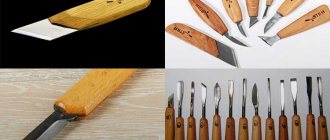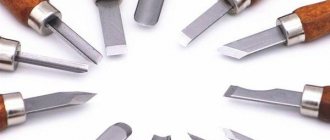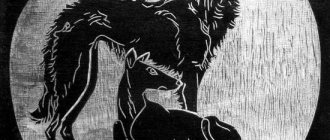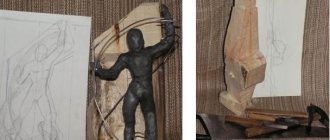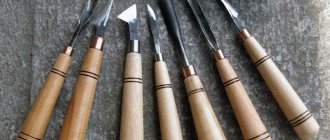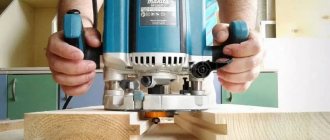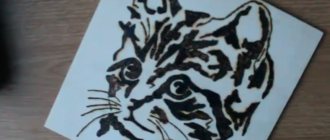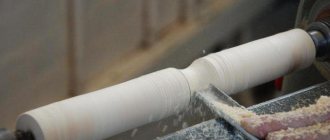Carbide knives
The effectiveness of a tool for wood processing (such important parameters as wear resistance and the quality of the processed surface) depends mainly on the material for making the working part of the tool.
Nowadays, superhard materials (for example, diamond), various hard alloys and tool steels are used for the working parts of tools in woodworking. Grades of hard alloys depending on the processing material :
Depending on the material being processed, one or another type of hard alloy is most suitable:
The information provided shows that purchasing expensive carbide knives is not a guarantee of quality results! On the contrary, the result can be negative, or maybe excellent, it all depends on the correct selection of carbide. To select the necessary carbide knives, you need to understand this relationship and delve a little deeper into the physical properties of the carbide. It is an alloy based on tantalum, titanium, tungsten carbides, connected by a metal binder - cobalt. Carbides in powder form are mixed with powdered cobalt, this mixture is pressed into products of the required shape for casting and sintered at a temperature close to the melting point of cobalt in a protective atmosphere. This is how carbide of various sizes and shapes is obtained, which is subsequently used to equip wood-cutting tools and carbide knives.
The physical and mechanical properties of the hard alloy depend on:
- chemical composition - percentage of cobalt in the alloy
- structures - carbide grain size
Characteristics of carbide:
*special carbide alloys
The more cobalt there is in a hard alloy, the more durable and tough it becomes, and it resists shock loads and vibrations well.
The larger the grain size of carbides in a hard alloy, the greater its strength, but the less wear resistance:
offers the following six product groups of carbide knives and blanks from:
First group - Replaceable polyhedral plates (SMP)
SMP, alpha = 35g. (alpha - back angle)
- Standard multifaceted plates are knives with a length of 7.5 to 120 mm, a width of 12 mm, and a thickness of 1.5 and 2.5 mm. The most used hard alloys are brands “T04F”, “T08F”, “T02SMG”, “T03SMG”.
- Non-standard polyhedral plates - knives with non-standard holes and various additional angles.
- Square polyhedral plates - knives with dimensions: 14*14*2, 14.5*14.5*2, 15*15*2.5, alloy grades “T08MF”, “T04F”.
- Scoring multifaceted plates - knives 14*28*2. The most used grade of carbide is “T08MF”.
- Groove knives - knives 34*16*4. The most used grade of carbide is “T06MF”.
- Standard multi-edged inserts with four cutting edges - knife 49.5*12*1.5. The most used grades of carbide are “T04F”, “T03SMG”, “T10MG”.
SMP, alpha = 45g.
- Multifaceted plates - knife 30*12*1.5.
- Multifaceted Microfinish plates.
- Mini polyhedral plates. The most used grades of carbide are “T04F”, “T03SMG”.
- Standard knives with chip breakers.
- Standard knives for processing radius edges and chamfers, as well as SMP systems: “Leitz”, “Oertli”, “KWO/Versofix”, “Kanefusa”.
The second group is blankets (without corrugation) for profiling special replaceable carbide plates.
- Blankets with one hole at the bottom
- Blankets with two holes at the bottom
- Blankets with one hole in the middle
- Blankets with two holes in the middle
- Special blankets for profiling
- Blankets without holes (resharpenable)
- Standard profile replaceable carbide inserts
The third group is blankets with corrugation.
- Blankets are corrugated with brazed carbide.
- Microsystem corrugated blankets “SuperPac”.
- The most used grades of carbide are “T10MG”, “T04F”.
- Blankets are corrugated with “EcoPac” holes.
- The most used grades of carbide are “T10MG”, “T04F”.
Fourth group - planing knives
- Planing knives made of massive carbide. The most used grade of carbide is “T10MG”.
- Planing knives with brazed carbide, as well as planing knives of the following systems: “Bulldozer”, “Terminus”, “Centrolock”, “Tersa”, “Centrostar”, “Centrofix”, “Quickfix”.
Fifth group - blanks for making brazed milling cutter blades
- Carbide strips for cutters.
- Carbide blanks for teeth of mounted milling cutters.
- Carbide blanks for end mill teeth.
- Blanks for carbide drills.
- Blanks for carbide teeth of minitenon milling cutters.
- Blanks for carbide teeth of circular saws. The most commonly used carbide alloys for all workpieces are “T06MF”, “T08MF”, “T10MG”.
The sixth group is carbide rods.
Rods with a diameter from 1.0mm to 35mm, length 325mm. The most commonly used hard alloys are “T10MG” and “T06MG”.
Price list for planing knives “Extra Cobalt”, high-speed steel NCV 8%
| Knife dimensions | Price/piece(EUR) | |||||
| H=30 | H=35 | H=40 | ||||
| 60×30/35/40×3 | 4.0 EUR | 4.8 EUR | 5.8 EUR | Buy | ||
| 80×30/35/40×3 | 4.2 EUR | 5.0 EUR | 6.0 EUR | Buy | ||
| 100×30/35/40×3 | 4.4 EUR | 5.3 EUR | 6.4 EUR | Buy | ||
| 110×30/35/40×3 | 4.6 EUR | 5.5 EUR | 6.6 EUR | Buy | ||
| 120×30/35/40×3 | 4.8 EUR | 5.7 EUR | 6.8 EUR | Buy | ||
| 130×30/35/40×3 | 5.0 EUR | 6.0 EUR | 7.2 EUR | Buy | ||
| 150×30/35/40×3 | 5.2 EUR | 6.2 EUR | 7.4 EUR | Buy | ||
| 180×30/35/40×3 | 5.4 EUR | 6.4 EUR | 7.7 EUR | Buy | ||
| 210×30/35/40×3 | 5.6 EUR | 7.0 EUR | 8.4 EUR | Buy | ||
| 230×30/35/40×3 | 6.0 EUR | 7.4 EUR | 8.9 EUR | Buy | ||
| 260×30/35/40×3 | 6.5 EUR | 8.0 EUR | 9.6 EUR | Buy | ||
| 300×30/35/40×3 | 7.4 EUR | 9.0 EUR | 10.8 EUR | Buy | ||
| 310×30/35/40×3 | 7.65 EUR | 10.0 EUR | 12.0 EUR | Buy | ||
| 410×30/35/40×3 | 10.2 EUR | 12.0 EUR | 14.4 EUR | Buy | ||
| 510×30/35/40×3 | 12.6 EUR | 15.0 EUR | 18.0 EUR | Buy | ||
| 610×30/35/40×3 | 15.2 EUR | 18.0 EUR | 21.6 EUR | Buy | ||
| 630×30/35/40×3 | 15.6 EUR | 19.0 EUR | 22.8 EUR | Buy | ||
| 640×30/35/40×3 | 16.0 EUR | 20.0 EUR | 24.0 EUR | Buy | ||
| 710×30/35/40×3 | 17.6 EUR | 22.0 EUR | 26.4 EUR | Buy | ||
| 810×30/35/40×3 | 20.0 EUR | 24.0 EUR | 28.8 EUR | Buy | ||
Carbide knives
The effectiveness of a tool for wood processing (such important parameters as wear resistance and the quality of the processed surface) depends mainly on the material for making the working part of the tool. Nowadays, superhard materials (for example, diamond), various hard alloys and tool steels are used for the working parts of tools in woodworking.
Grades of hard alloys depending on the processing material:
Depending on the material being processed, one or another type of hard alloy is most suitable:
The information provided shows that purchasing expensive carbide knives is not a guarantee of quality results! On the contrary, the result can be negative, or maybe excellent, it all depends on the correct selection of carbide. To select the necessary carbide knives, you need to understand this relationship and delve a little deeper into the physical properties of the carbide. It is an alloy based on tantalum, titanium, tungsten carbides, connected by a metal binder - cobalt. Carbides in powder form are mixed with powdered cobalt, this mixture is pressed into products of the required shape for casting and sintered at a temperature close to the melting point of cobalt in a protective atmosphere. This is how carbide of various sizes and shapes is obtained, which is subsequently used to equip wood-cutting tools and carbide knives.
Wood carving tool.
There does not seem to be a single classification of wood carving tools. In different books, a variety of instruments are called cutters, jambs, kljukarz, shtikhel, geysmus and tsarazik. Moreover, one comes across all sorts of pearls of fine literature, for example, “semi-cool chisels”, or “chisel squares”, not to mention the completely vulgar one - “cool jambs”.
I cannot guarantee that the classification given below is correct and the only correct one forever and ever, amen. And, of course, not the most complete. I will only write about those tools that I know how to use myself and for which I can vouch. In the future, describing in detail the different methods of carving, we will consider each tool separately: where to get it, how to make it, how to use it, etc. etc.
Knives:
Every knife, be it a wood carving knife or just a kitchen chopping knife, must have a spout, a back, a heel, a shank and a handle. These features make it easy to distinguish knives from other tools. The following knives are used in wood carving:
Cutters. Carvers, in conversation, often simply call them knives. They come in different shapes and sizes, but they all have a cutting angle of exactly thirty-five degrees. Cutters are the most important tool among knives, and probably among all other tools. Every carver has their favorite cutter. With it he performs the main and most delicate work.
Jambs:
Jambs. These are knives that are used in flat-relief carving for cutting long straight lines, for rounding contours and for processing the side walls of grooves. The main feature of the jambs is the cutting angle of sixty degrees.
Auxiliary knives:
Auxiliary knives. I don’t know what these knives are called, but that doesn’t stop me from using them for many years. In books they are sometimes called cutters, and sometimes blunts. I don’t want to invent, following the example of some, another masterpiece of literature. Number one is used for final finishing of curved surfaces in solid threads, and number two is indispensable in slotted threads.
Chisels:
1.Straight:
Straight chisels (flat chisels). They are easy and simple to recognize. And straight chisels are used for cleaning and leveling flat surfaces in carvings on a plane.
2.Semicircular:
They come in both very large and very small sizes. In addition, each semicircular chisel has a height and a bend radius. If the height is greater than the bend radius, then the chisel is called steep; if it is much greater, then it is called a tsarazik; if it is much less, it is called a sloping chisel; and if it is equal, it is called a medium chisel. The main purpose of semicircular chisels is volumetric classical carving. They are also used in flat-relief carvings.
Klyopiki:
Studs come in a variety of sizes, but they have only three sharpening shapes: leaf, sword and nail.
The first two are called: leaf rivets and sword rivets. They are used in flat-relief and volumetric carvings to clean up the background in hard-to-reach places.
Marigold:
Marigold. Marigolds differ from ordinary rivets in the shape of their sharpening. It resembles a fingernail, which is why they got their name. But the purpose of marigolds is the same - cleaning in hard-to-reach places. Without marigolds, in many cases, beautiful, clean carving is not possible.
Cranberry cutters:
This is the name of a group of instruments that have two bends of one hundred and twenty degrees. This, as you probably already guessed, is done so that, when carving, the handle does not touch the surface being processed. According to their intended purpose, cranberries are very different. There is a cranberry-semicircular chisel, a cranberry-marigold, etc. etc.
Geismus(Eismus, eismus):
Geismuses. They are often called corners, but this is not correct. Geismus is Geismus. The best bend angle is forty-five degrees.
Stichel:
Stichels always have a bend angle of fifteen degrees. Their handles are most often in the form of a fungus. All these signs are true only for wood carving tools. Stichels for carving bone, or, for example, metal, look completely different. Stickers serve for different purposes and are used in different types of carvings.
Spooners:
Spoon knives (spoon knives). The best spoon holder is a sharpened ring with a rod welded to it. There are other options, but they are all less convenient to use. Spoons are needed to remove a large amount of material in the recesses and to process the internal walls when making dishes. They are also used in flat-relief carvings.
And in all types of threads, without exception, ordinary drills inserted into the handles are used. Agree that it is not always convenient to drill holes in a craft that is already half done. You can’t hold it in a vice, and the accuracy is not the same.
A long time ago, when I was little, a book by a group of authors was published - A. A. Abrosimova, N. I. Kaplan, T. B. Mitlyanskaya. The book was called “Artistic carving on wood, bone and horn.” It was there that this drawing was first published, which has since traveled from book to book. The knife shown in the picture was something I foolishly made once. I copied everything one to one, accurately observing all proportions. It is very difficult to cut with such a knife. Almost impossible. Now, if you sharpen it not on the side indicated, but on the opposite side, and turn the handle inside out, then something else will happen.
Not everything is clear with chisels either. What kind of handle is this, half the palm of your hand? In addition, judging by the picture, they are all sloping. Such chisels can indeed be used for sculptural carving, but better as an auxiliary tool. Otherwise, the process of creating a sculpture threatens to stretch out indefinitely. For full-fledged volumetric wood carving, a set of cool chisels is absolutely necessary. In addition, it is, of course, possible to use chisels and a knife alone, but it is not advisable. There are many more tools that can and should be used in volumetric carving.
Good cranberries (or cranberry cutters, depending on who you like) have two bends of exactly one hundred and twenty degrees - no more, no less. In stores, you most often find tools with ninety-degree bends, or with different bend angles. Never take them unless you are a masochist. You'll be tortured! The blade will constantly cut into the depths of the tree, and leave uneven furrows, instead of quietly choosing the background.
It also happens that there are cranberries with regular bends, but with such a short bridge that the distance between the base and the cutting part is less than the radius of the handle. When buying cranberries, remember that the purpose of their existence on this planet is to be able to process a plane without scraping the handle on the wood.
Planing knives for machines
- Product added to comparison
- Product added to favorites
Planer knife for jointer HSS 260x25x3 mm for JPT-260 1 piece JET Pilana art.SP260.25.3
- Paid delivery 500 rub.
- 0 reviews
- Are available
- Buy
- In one click
- Product added to comparison
- Product added to favorites
Planer knife for thicknesser T-600J 4 pieces PROMA art. 65600001
- Free shipping
- 0 reviews
- Are available
- Buy
- In one click
- Product added to comparison
- Product added to favorites
Planer knife for jointer DS analogue 8Х6НФТ 155x19x3 mm for 54A 1 piece JET Pilana art.DS155.19.3
- Paid delivery 500 rub.
- 0 reviews
- Are available
- Buy
- In one click
- Product added to comparison
- Product added to favorites
Helical cutter shaft for 54A JET art.JJ6HH-CA
- Free shipping
- 0 reviews
- Are available
- Buy
- In one click
- Product added to comparison
- Product added to favorites
Planer knife for jointer HSS 210x19x3 mm for PKM-300 1 piece JET Pilana art.SP210.19.3
- Paid delivery 500 rub.
- 0 reviews
- Are available
- Buy
- In one click
- Product added to comparison
- Product added to favorites
Planer knife for jointer DS analogue 8Х6НФТ 205х19х3 mm for 60A 1 piece JET Pilana art.DS205.19.3
- Paid delivery 500 rub.
- 0 reviews
- Are available
- Buy
- In one click
- Product added to comparison
- Product added to favorites
Helical cutter shaft for JJ-866 JET art.JJ866HH-CA
- Free shipping
- 0 reviews
- Are available
- Buy
- In one click
- Product added to comparison
- Product added to favorites
Helical cutter shaft for PJ-1696 JET art.PJ1696-001
- Free shipping
- 0 reviews
- Are available
- Buy
- In one click
- Product added to comparison
- Product added to favorites
Planer knife for surface planer D 27300 2 pieces DeWALT DE 7333
- Paid delivery 300 rub.
- 0 reviews
- Buy
- In one click
- Product added to comparison
- Product added to favorites
Planer knife for surface planer 2012 NB 2 pieces MAKITA 793346-8 art.121168
- Paid delivery 500 rub.
- 0 reviews
- Are available
- Buy
- In one click
- Product added to comparison
- Product added to favorites
Helical cutter shaft for JPT-310 JET art.JPT310HH-071CBA
- Free shipping
- 4 reviews
- Are available
- Buy
- In one click
- Product added to comparison
- Product added to favorites
Planer knife for jointer DS analogue 8Х6НФТ 210х19х3 mm for PKM-300 1 piece JET Pilana art.DS210.19.3
- Paid delivery 500 rub.
- 0 reviews
- Are available
- Buy
- In one click
- Product added to comparison
- Product added to favorites
Price list for planing knives “EXTRA CHROME” (Global Edge - TL), high-speed steel ECH 8%
| Knife dimensions, mm. | Price | |||
| 60 x 35 x 3 | 6.0 EUR | Buy | ||
| 80 x 35 x 3 | 6.2 EUR | Buy | ||
| 100 x 35 x 3 | 6.5 EUR | Buy | ||
| 110 x 35 x 3 | 6.8 EUR | Buy | ||
| 120 x 35 x 3 | 7.0 EUR | Buy | ||
| 130 x 35 x 3 | 7.4 EUR | Buy | ||
| 150 x 35 x 3 | 7.6 EUR | Buy | ||
| 180 x 35 x 3 | 8.0 EUR | Buy | ||
| 210 x 35 x 3 | 9.0 EUR | Buy | ||
| 230 x 35 x 3 | 10.0 EUR | Buy | ||
| 260 x 35 x 3 | 11.0 EUR | Buy | ||
| 300 x 35 x 3 | 12.0 EUR | Buy | ||
| 310 x 35 x 3 | 13.5 EUR | Buy | ||
| 410 x 35 x 3 | 16.0 EUR | Buy | ||
| 510 x 35 x 3 | 19.2 EUR | Buy | ||
| 610 x 35 x 3 | 23.0 EUR | Buy | ||
| 630 x 35 x 3 | 24.0 EUR | Buy | ||
| 640 x 35 x 3 | 25.2 EUR | Buy | ||
| 710 x 35 x 3 | 26.4 EUR | Buy | ||
| 810 x 35 x 3 | 30.0 EUR | Buy | ||
To receive more detailed information about the products you are interested in, fill out a simple online request form or call: . 302, 317, 322, 230 - for calls from Moscow and the Moscow region or +7 - free call throughout Russia.
Go to the catalog of woodworking equipment
